2-Handed Kettlebell/Dumbbell Clean + Squat + Strict Press
Subscribe to MTI's Newsletter - BETA
Q&A 3.22.18
QUESTION
ANSWER
QUESTION
ANSWER
QUESTION
hi rob…i’m a very fit soon to be 58 yo male. saw some of your w/o’s in recent men’s health magazine. i’m tired of my existing w/o regimen but a little overwhelmed w all the options on your website. can you help me? i’m old school and have never even considered a coach, let alone a virtual one. i do have age related limitations. surgeries on both knees, r elbow, r shoulder. everything works, just not as well as it did 10 yrs ago. i completed a tough mudder 5 yrs ago, no problem, considering another one this summer to see if i can and to piss off my lazy buddies.
ANSWER
QUESTION
ANSWER
QUESTION
Back in 2012 I purchased a Goruck challenge plan from Rob and it really helped me prepare for it and I did well. I just signed up for an event where you ruck 50 miles in 20 hrs or less, with a 20-30lb ruck. The event is 12 weeks away. I was wondering which program do you recommend for this event ? I have seen a few on the site, but which is best ? I am 49 yrs old. Thank you,
ANSWER
QUESTION
Need advice on which plan to use. I report in 6 weeks to be a ranger instructor and for some odd reason I have to take all the physical test again. I am in decent shape, have been doing the best ranger workout but felt like it neglected my ability to do a lot of push ups. I want to continue to gain strength and size result because I’m a skinny dude but at the same time still be able to be a runner. Any advice would help
ANSWER
QUESTION
ANSWER
QUESTION
I looked at your website after learning about your company from the current issue of Men’s Health.
Here is my goal: I have signed up to climb Kilimanjaro in early September. I am traveling with Wilderness Travel on the Lemosho-Crater Camp Route, with 7 days for the ascent.
Here is my situation: I will turn 66 in July. I currently weigh 195, which is probably 20 – 35 pounds above where I should be for a male 5’7”.
The last time I did anything serious mountain-hiking wise was back in August, 2009, when my wife and I trekked to Machu Pichu and went with an REI group along the High Inca Trail (aka the lodge trail), where we topped out at 15,200 ft. before beginning the descent to Aqua Caliente. Back then, after training on hills and mountains in Southern California (I live in Los Angeles), I was at 167 pounds, and felt like I was in pretty good shape (at least cardio wise)
So, I need to drop weight, build up my hiking legs again, build up my cardio endurance, build up my upper body strength (although my understanding is that at Mt. Kili I will probably only be carrying a day pack with water, camera, some snacks, etc., or maybe 20 pounds), and practice with climbs (the highest I will be able to train in the Sierras is a bit over 14,000).
I realize that I am probably not a typical client for your various training regimens, but looking at your website makes me think that some of them can be easily adapted to my needs.
I would appreciate any advice you might have for me.
ANSWER
QUESTION
ANSWER
QUESTION
I started the Big 24 strength program and was wondering how long my rest between sets should be?
ANSWER
QUESTION
ANSWER
QUESTION
My daughter will be 16 in about 5 months. She’s interested in doing weights or strength training to improve her running. She does cross country (5k distance) in the fall, and right now track season just started. She runs the mile and half mile. Would one of your programs have what she needs? What would you recommend?
ANSWER
QUESTION
I have been nursing a strained Achilles tendon since November, no running or plyometrics, physical therapy for 4 weeks, and nothing is helping. The next course is a cast for 6 weeks to try and rest it in order to heal it. I have been going crazy without being able to do “cardio” and have been lifting weights to try and keep up my strength. I was looking at your leg injury program as a potential to keep me motivated and not depressed while still getting stronger. I am active duty Army and will have to take my APFT in April. I will be able to conduct the bike test in lieu of the 2-mile run but I was just wondering if I would be able to do this program while in a cast or walking boot? Are the exercises demonstrated or at least explained? Things like the Mantis and Mr. Spectacular?
ANSWER
QUESTION
I was following your Backcountry pre season training before Christmas, I was wondering what “in season” training you would recommend?
I can see there’s the normal in season work out, I was wondering if there was something more Backcountry/skinning orientated?
Also, regarding the step-ups – the weight carried, should this be my total ski set up weight I.e. the combined weight of my skins, skis, backpack right down to underwear?
What do you think to adding ankle weights? I say this as a single boot plus crampon can be 1.5kgs alone. Or is the idea of the step ups just to train the muscle rather than to train the body for the the weight it will experience in the field?
Thanks,
ANSWER
QUESTION
I’ve been in le for 18 years. The last 13 in swat. Now I’m the old Sgt (43 yo). Trying to keep up with the new guys but I do know the limitations. Looking to pick a program
ANSWER
QUESTION
I have a selection date in 7 mo, the ruck based training packet is right at a year. Are there any suggestions on how to trim it down?
Thanks!
ANSWER
QUESTION
Me and my LE partner have done multiple plans with great success, but we are kind of at a cross roads. We have done the GUN Series , Spirit series, SWAT selection, bodyweight foundation, and then several of your legacy programs. We are both investigators with a 3 letter agency and both on are agencies SRT team. We took a break from your programming for about the last 2 months. Your programs are amazing (ran them about 2-3 yrs straight), I’m just a meathead at heart, so I went back to a program I have done multiple times to put size on. Well we finished that and are trying to figure out the next workout plan. I see that you have done a movie series and I’m extremely interested in the Dirty Harry Gym Based Endurance, (60 mins of none stop exercise) and wondering what your thoughts were on the results?
On us, we are both in good shape, but are not where we were in regards to work capacity when we ran your programming. We also have a fitness test coming up in about 5 months which has the 300 meter run and 1 1/2 mile run (we use the FBI PFT prior). I’m a bigger guy, (6’3, 245lbs) so I know I need to start getting my calves used to running more. I run about once a week now, with either intervals of 400s or 800s. My calves always become a problem when I’m training up, so I need to be careful.
Anyways I’m not sure if we should do the bodyweight build, Cop movies, Seiko program, or just redo the gun series. I’m open to suggestions and thank you for the work you do. $29 a month is nothing compared to what I’ve gotten out of your programs and site.
ANSWER
QUESTION
ANSWER
QUESTION
ANSWER
QUESTION
ANSWER
Subscribe to MTI's Newsletter - BETA
Arete 3.22.18
Military
Guns, Drones, & Augmented Reality: Army Seeks Infantry Revolution, Breaking Defense
15 Years After Invading Iraq: Winning the War, But Still Fighting for Peace, The Cipher Brief
Interim solution for US Army’s Short Range Air Defense to be chosen by end of year, Defense News
Military leaders hit Capitol Hill, Defense News
How to Beat Russia and China on the Battlefield, Real Clear Defense
Navy Will Send Stealthy, Carrier-Launched F-35C to War in 2021, Warrior Maven
Army, Struggling to Get Technology in Soldiers’ Hands, Tries the Unconventional, Small Wars Journal
Turkey Threatens to Attack Syrian Town held by Turkish Troops, Military.com
Navy Training for War with Russia in the Arctic, The National Interest
Mattis Fires a Clear Shot, War on the Rocks
How the Ambush of US Soldiers in Nigeria Unfolded, NY Times
Military Reviews Rules for Helmet Cams after Nigeria Attack, In Homeland Security
New Youtube Policy Cracks Down on Gun Channels, Recoil
USMC Plans to Replace Newly Fielded Glocks with Modular Handgun System, Soldier Systems
USAF OCP Transition Update, Soldier Systems
The New ‘Cold War’ With the West Heats Up, Real Clear Defense
Resolute U.S. Response Needed After Russian Spy Poisoning Incident, Hoover Institution
Homeland Security / First Responder / Wildland Fire
Nerve agent was placed in former spy’s BMW ventilation system: U.S. intel, Homeland Security News Wire
Cyber Threats to the Aviation Industry, Real Clear Defense
ALABAMA FIREFIGHTERS SERIOUSLY INJURED AT LIVE FIRE TRAINING, FirefighterCloseCalls.com
Reward for Austin Serial Bomber tops $100K, Law Enforcement Today
Arkansas County Locates School Shooting Hoax 9-1-1 Caller With Solacom Mapping Software, Police Magazine
Wildfire starts on Colorado military post, burns 2,100 acres, Wildfire Today
State Department’s Vague Mexico Travel Warnings Causing Chaos, In Homeland Security
Re-Thinking the Reasoning Behind Picking Leaders, LE Today
Slain Chicago Police Commander Was Shot 6 Times, Police One
Mountain
Remembering Alpinists Marc-André Leclerc and Ryan Johnson, Climbing Magazine
Security System: Why, even after three decades, the Voilé strap remains the most relevant tool in any kit, Backcountry Magazine
Deer Management Research At Its Finest, Bowhunter
The Epic Pass Just Got More Epic, Powder Magazine
Podcast: How to Overcome Fear in Climbing with Author Roanne van Voorst, TrainingBeta
Team USA Is Dominating the Paralympics, Outside Magazine
Patagonia Micropuff Hoody Review, Backpacking Light
Arcteryx Nuclei AR Review, Backpacking Light
Montana Skier Obliterates Single Day Record for Human Powered Vertical, Unofficial Networks
This One Graphic Will Help You Decide Which Pass To Buy Next Season, Unofficial Networks
Target Panic?, Bowhunting.net
Climbing’s Growing Problem: The Mentorship Gap, Outdoor Research
First Wisconsin Elk Hunt Scheduled for 2018, Bowhunting Blog
The Pro Snowboarder Who Became an Award-Winning Filmmaker, Red Bull
Fitness / Nutrition / Health
The Suplex: A How-To Guide for Back Mobility, Breaking Muscle
Consuming low-calorie sweeteners may predispose overweight individuals to diabetes, Science Daily
Is the Autoimmune Protocol Right For You? Mark’s Daily Apple
How Bad Is Bacon? Nutrition Facts
How Training for the Paralympics Became a Full-Time Job NYT
9 Foods Athletes Should Eat Every Day, Outside Magazine
We Need More Female Leaders in Olympic Sports, Outside Magazine
5 Instant Coffees that Don’t Suck, Gear Patrol
Why Caffeine May Not Make You Faster, Outside Mag
Inside the Super Rugby Camp: How Players Recover Between Games, Men’s Health
Male Birth Control Pill Shows Early Promise, WebMB
The 20 Pieces of Equipment You Need for your Home Gym, Men’s Health
Physically fit women nearly 90 percent less likely to develop dementia, Science Daily
The Best Recovery Tools, Outside
7 Beginner-Friendly Ultramarathons, Outside
Subscribe to MTI's Newsletter - BETA
Join the MTI Team as our Director of Research!

The Mountain Tactical Institute in Jackson, WY seeks an agile, innovative, thinker, willing to buck convention and ask hard questions. We work to improve mission performance for mountain and tactical athletes and keep them safe.
Your research will be multi-faceted: Fitness programming; Mental fitness and stress inoculation; Event nutrition; Mountain/battlefield safety practices; Mountain and tactical movement efficiency; Gear/materials testing and analysis; Technical skills instruction; Research and analysis.
QUALIFICATIONS:
Masters degree or Ph.D. and extensive research experience.
Study design mastery and statistical wiz.
Excellent writer – both technical and journalistic.
Athletic and Fit. (You’ll be your own lab rat …)
Desire to be part of something bigger than yourself.
Salary- $70-100K, DOE
To apply, e-mail resume, cover letter, and references to rob@mtntactical.com
Subscribe to MTI's Newsletter - BETA
1-Arm Kettlebell/Dumbbell Press
No Legs! Strict!
Reps … 2x = 2x each arm = 4x total.
Subscribe to MTI's Newsletter - BETA
2-Handed Kettlebell/Dumbbell Clean and Strict Press
Strict press …. no legs! Lab Rat James makes it look easy with these 32kg kettlebells ….
Subscribe to MTI's Newsletter - BETA
2-Handed Kettlebell/Dumbbell Clean
Can be completed with dumbbells or kettlebells. Video below shows kettlebells. HERE is a dumbbell example.
Subscribe to MTI's Newsletter - BETA
V-Sum, Hinge Lifts, and Campus Board Work: Program Design behind our 2018 Pre-Season Rock Climbing Cycle
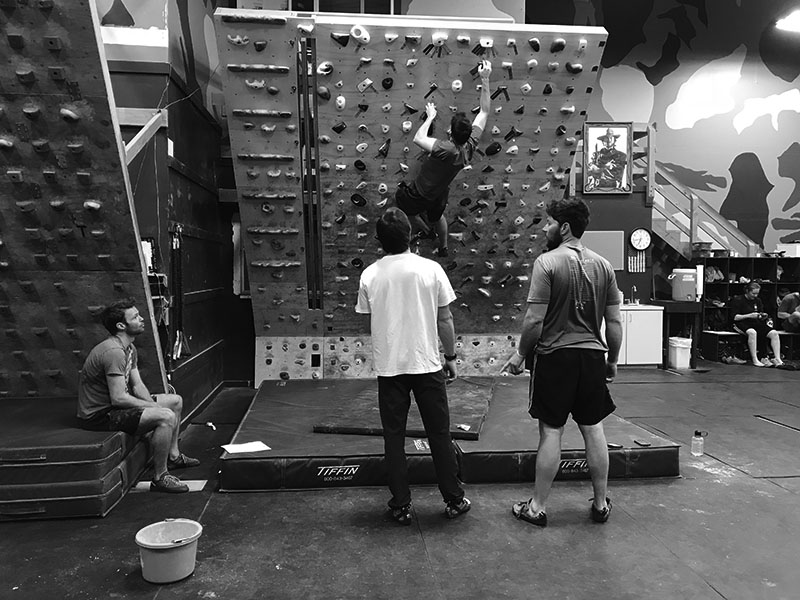
By Rob Shaul
Founder/Coach
Background
One of my earliest mistakes as a strength and conditioning coach was trying to use general fitness programming to prepare local rock climbers for their annual Spring Break climbing trips to the desert Southwest.
This was my first year as a coach with my own gym here in Jackson, and at the end of that cycle, boy were my climbers good at squats, burpees, swings, sprints, pull ups – you name it. They trained hard and heavy for an intense 6 weeks.
And boy were they mad at me upon return from their climbing trips to Utah and California. It turns out that burpee fitness does not transfer to the very narrow, sport-specific finger and grip strength deployed for rock climbing. Immediately I purchased every book on rock climbing training and program design I could, and began reading and testing. I invested in some system boards in my gym for sport-specific programming and things have progressed on and on from there.
As a strength and conditioning coach, I’ve learned that good sport-specific program design really begins with a knife. Identify what the fitness demands of the sport or event are, which exercises you have available in the gym to train them, and focus on what transfers by cutting out the extra stuff.
This focus and cutting takes confidence and experience and continues to this day.
What is Climbing Fitness?
Ninety-five percent of climbing fitness is finger/grip strength related. Upper body pulling strength is far less a determinate of climbing ability than one might think. We’ve seen this many times – women who struggle with simple pull ups, regularly outperform men on our system boards and out climb men on actual rock.
Body tension is another component of climbing fitness I’ve honestly struggled to identify, and similarly struggled to find progressable, gym-based exercises to train. On actual climbs, you’ll see body tension come into play when reaching for wide holds, or for contact strength on small holds or slopers. Some coaches use levers to train this, but I’m not convinced of the transfer to the actual sport. As a whole, however, body tension is not nearly as important to finger/grip strength for climbing performance.
As well, Base or general strength and fitness is not super important. We’ve had world class, national champion climbers in our gym for photo shoots, who struggled with simple push ups and squats, could barely do sprints or any cardio, and smoked cigarettes outside between photo sets! But their fingers had re-bar like strength, and their forearms rivaled Popeye’s. They onsighted the hardest bouldering problems in the local climbing gym, no problem.
“Intensity” applied to Rock Climbing
To understand this concept, I need to take you to the gym and use a barbell example.
In strength and conditioning terms, “intensity” means the load on the barbell.
The heavier the barbell, the higher the “intensity.”
And, if you’re just doing regular reps, the heavier the barbell, the few reps you can do, and thus, the less time you have under load, or ” tension.”
In my programming for climbing, I’m applied this “time under tension” to programming.
See the chart below:
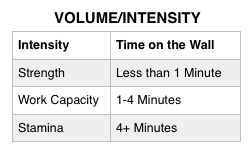
Understand for time what I mean here is how long the athletes are hanging on their fingers/grip.
Strength efforts are short, hard and intense. We can use both timed intervals and campus dyno and lock and reach reps for progression. More and more I find I use the campus boards for our rock climb training.
Work capacity events are perhaps the most painful for our lab rats. These longer intervals on the wall should end intensely for the athletes. Often our athletes will be “chicken winging” – fighting to stay on at the end of the interval – you’ll see some of this in the videos below.
Stamina efforts are much longer, but not nearly as intense. In general fitness terms, these should feel like a long easy or moderately paced distance run.
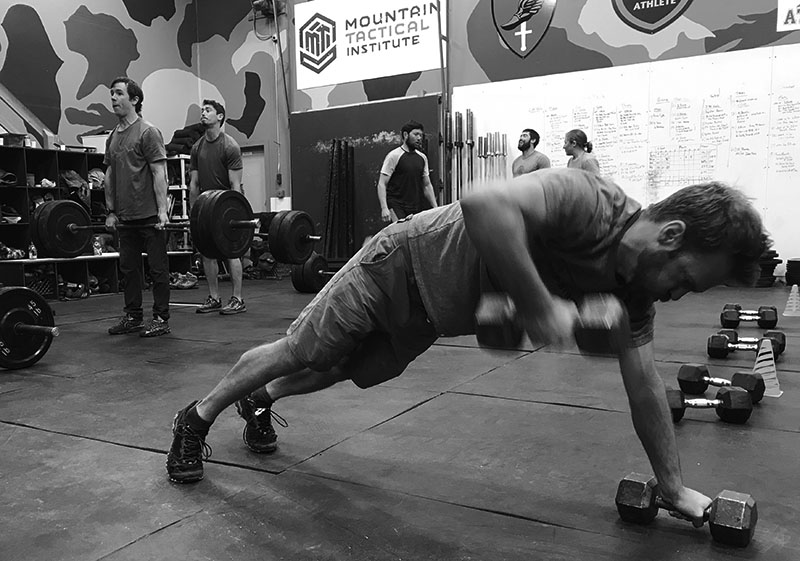
Spring 2018 Rock Cycle Design
In the past year, we’ve purchased a new rock climbing training tool in my gym – a Moon Board. Developed in the UK, the Moon Board standardizes holds and hold placements, and uses lights and a smartphone app for creating an unlimited number bouldering problems of different grades in a very compact space.
Rock climbers have a constant, shifting imbalance between climbing fitness and climbing technique.
Brand new climbers have a wide imbalance – they are plenty strong for the low rated climbs, but are limited by technique.
But soon, technique catches up, and the imbalance between fitness and technique becomes much more narrow.
Experienced climbers constantly battle this imbalance, not only in their general terms but also on specific bouldering problems or routes.
Until our Moon Board purchase, I really had no way to train “technique” in my facility – so our past cycles have focused purely on fitness.
Our Moon Board has allowed me to deploy perhaps my favorite Rock Climbing training event – the Bouldering V-Sum.
The Bouldering V-Sum is a super efficient and enlightening way to train both rock climbing technique, and climbing fitness strength concurrently. For this cycle, I deployed a 6-problem V-sum on a 50-minute timer. After a short 5-minute warm up on the system wall, my climbers had 50 minutes to work boulder problems on the Moon Board. At the end of the 50 minutes, they added up their top 6 problems for that days’ V-sum. The goal was to have the V-sum’s continue to improve/increase over the course of the cycle.
The Moon Board gave me the ability to use the V-sum as a training tool in my own gym. But I also made a significant programming change this cycle – I focused my climbing lab rats’ climbing fitness training only on strength. From the volume/intensity chart above, in past cycles, I’ve also deployed longer work capacity and stamina efforts, but this cycle I abandoned these for a strength focus.
I narrowed this further and deployed just 3 strength “exercises”: Bouldering V-Sum on the Moon Board, Dynos on the Campus Board and Dead Hangs on the campus board.
Here in Jackson, not much rock climbing occurs in the fall and winter. So athletes begin these cycles relatively “unfit” in terms of focused finger and grip strength for climbing. What this means for me practically, is for the first 3 weeks, I can train fingers/grip hard for two days in a row, but have to give my climbers fingers/grip a break on the 3rd day of programming, and they can hammer them again on the fourth day in a 4 day/week cycle (Mon-Thurs).
After 3 weeks, I can train their fingers/grip 4 days/week.
Also, within training sessions, I’ll design work to give climbers’ fingers a break between climbing fitness events – and have them do some type of other training.
This cycle, the primary focus of this non-climbing fitness training was training body tension using heavy hinge lifts. The second day of the cycle we conducted a 1RM Hinge Lift assessment, and for the first 2 weeks, deployed eccentric hinge lifts based on their 1RM results. I conducted another 1RM Hinge LIft Assessment on week 4 and for the weeks 4 and 5, we used concentric hinge lift training in a density format.
Because their fingers/grip needed a rest after 2 days of training, for weeks 1-3 I had them do some gym-based endurance general conditioning work on Wednesdays. But weeks 4-5, we placed in another V-Sum.
Schedule for Weeks 1-3:
- Monday: Bouldering V-Sum on Moon Board
- Tuesday: Campus Board Dynos, Hinge Lifts, Dead Hangs
- Wednesday: General Fitness – Gym-Based Endurance
- Thursday: Campus Board Dynos, Hinge Lifts, Dead Hangs
Schedule for Weeks 4-5
- Monday: Bouldering V-Sum on Moon Board
- Tuesday: Campus Board Dynos, Hinge Lifts, Dead Hangs
- Wednesday: Bouldering V-Sum on Moon Board
- Thursday: Campus Board Dynos, Hinge Lifts, Dead Hangs
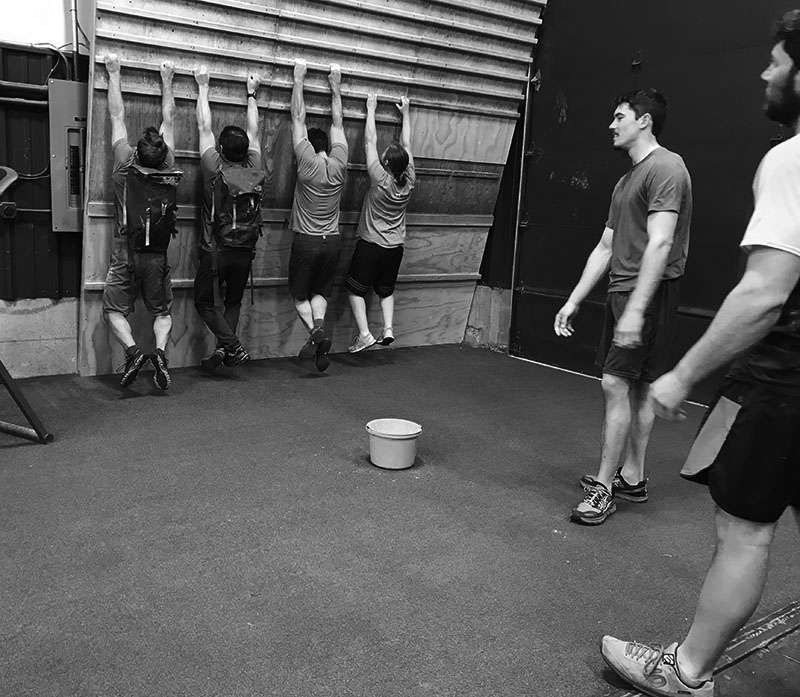
How Has The Cycle Been Going?
We have one more week. I’m using the V-Sum scores as my primary measure of cycle effectiveness, and weeks 1-3 we saw some rapid and steep V-Sum improvement. This week, there was still improvement, but certainly, the pace has begun to taper and plateau.
Campus Board Dynos are one area where progression is difficult to program ahead of time. It seems that nearly every athlete gains dyno strength at a different pace. What this means for me as the coach, is unlike our strength programming, I’m unable to pre-determine the progression, and have to watch each athlete individually.
Campus Board Dyno progression is a manuscript of information on its own. Our Campus Boards all have the same angle – what differs is the thickness of the campus rungs. The easiest board has the widest rungs – the hardest board has the narrowest rungs.
My goal in terms of progression is to get the athletes to be able to dyno up and down the easy campus board, then move them to the medium board, and eventually to the hard board. I really like campus dynos as a rock climbing strength training tool and have found them to be the most intense, and focused way to train finger contact strength. Watching climbers dyno on a campus board non-climbers marvel at their pulling strength as they “pop” up with no feet.
But what is really impressive, and what is really being trained is the ability to pull on their fingers, and then “catch” when they reach the next rung. Going up the board is relatively easy. Dynoing down the board is where finger strength – and contact strength is seriously taxed.
For this cycle’s campus dyno progression I’m using 10 rounds of dynos, with 45-75 seconds rest between rounds. If athletes can dyno up the board, I’ll progress them first to laddering up, feet on, then dynoing down. Next is to dyno up and down hitting each run, and finally to dyno up and down skipping one rung. Once they can do this, I move them to the next harder board, and begin the process again. Of the 8 lab rats in this cycle, two are able to dyno up and down on our hard campus board.
My dead hang progression initially deployed 10 rounds of a 20/40 work to rest interval: dead hang for 20 seconds, rest for 40 seconds. However, I found my athletes simply have not been improving. We’ve been doing these on our campus boards and improvement means making all the intervals at one board and then moving to the next harder board (narrower rungs). If the athlete can make all 10 rounds unloaded on the hard board, I add a backpack with 10-pounds, and increase the load in 10 pounds increments if they continue to improve.
Over the course of this cycle, however, I’ve had just 2 athletes progress, and I’m not sure why. I suspect my interval is wrong and I’ve added to my research to-do list a mini-study aimed at identifying the optimal dead hang interval for strength improvement.
Will this focus on strength and the bouldering V-Sum transfer to the real thing? Based on the V-sum improvement, it has to, I would think …. but, I won’t know until my athletes return from their Spring Break climbing trips and report back.
Questions/Comments/Feedback? Email rob@mtntactical.com
You Might Also Like MTI’s Rock Climbing Preseason Training Plan
Subscribe to MTI's Newsletter - BETA
Our Most Common Subscriber Questions
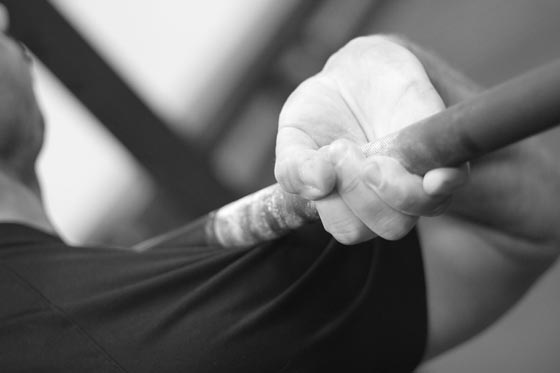
By Mintra Mattison
These are the most common questions we receive from our subscribers.
(1) Which program do you recommend?
If you’re not sure which program works best for you, you can take the MTI Survey to find a fitting training plan.
If you’re still not sure, email Rob. He answers dozens of questions daily and will be happy to answer yours.
→ Ask Rob
(2) Will I have access to all plans simultaneously?
Yes, with the Athlete’s Subscription Package you will get access to everything MTI has to offer.
This includes all of our 200+ plans, our educational online courses, as well as our day-to-day programming for LE, Military and Mountain Athletes.
(3) What does 3/5 Pull Ups or Squat @45/65# mean?
Whenever there are two numbers. The first is always the weight or amount of reps for female athletes. The second is always for male athletes.
So in this example:
Female athletes do 3 Pull Ups, while male athletes do 5.
Female athletes will perform the Squat with 45#, while male athletes use 65#.
(4) How do I access my plan?
All of our programming is online. You can access your subscription through your account on our website. All you need to do is log in and follow these instructions.
(5) Can I print out training sessions?
Yes, you can print out every week of your training plan simply by hitting Print under the file tab of your internet browser.
It is set up so the whole week will fit on a standard letter size sheet. You might have to adjust your printer layout settings to Landscape.
(6) I can’t find a particular training packet.
If you search for the particular Training Packet you will find the Packet Overview. This will guide you through the plans in the packet. It’s like a map that tells you which plan to start with and which plan to do next. You will have to look for each plan individually by using the search button.
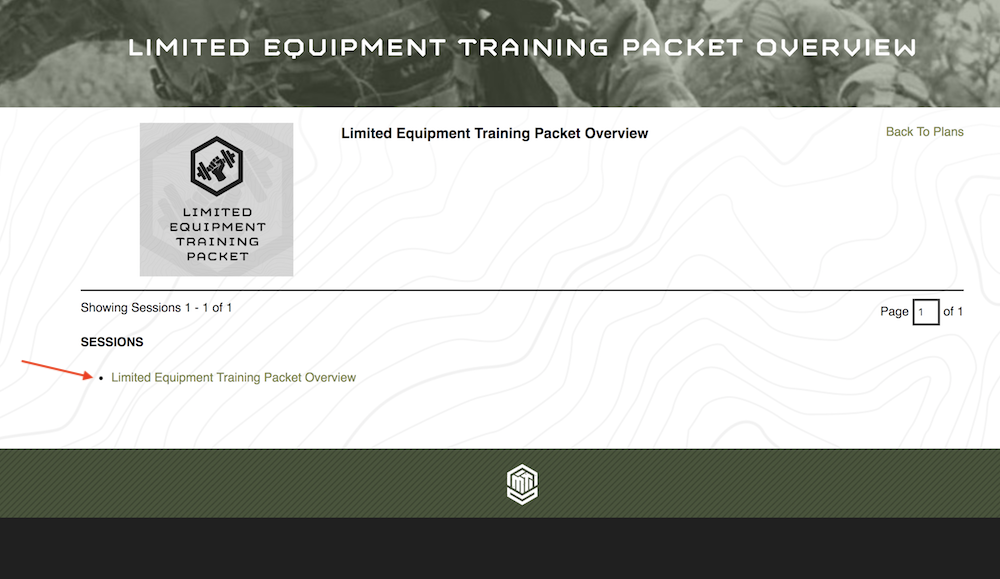
(7) How can I reset my password?
You can request a new password by hitting “Lost your password” or Email us directly at support@mtntactical.com
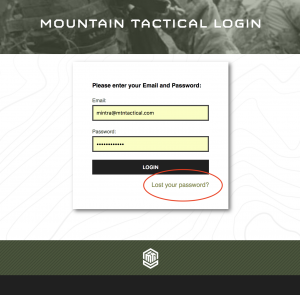
(8) If a plan gets updated, how do I make sure I am using the most recent version?
Whenever we update a plan, we replace the old version by uploading it to our library. This way, you automatically have access to the most recent version. If you already started with the old version, roll right into the next session of the new version.
(9) What are the “Legacy” Plans?
We’ve been designing sport-specific training plans for over a decade and these plans have older programming but are proven, athlete favorites. They are solely available to subscribers.
Did we miss your question? Please email us at support@mtntactical.com
If You’re Thinking About Subscribing You Might Also Like Individual Plan or Athletes Subscription
